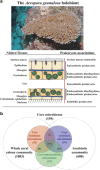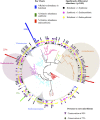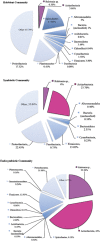The coral core microbiome identifies rare bacterial taxa as ubiquitous endosymbionts
- PMID: 25885563
- PMCID: PMC4579478
- DOI: 10.1038/ismej.2015.39
The coral core microbiome identifies rare bacterial taxa as ubiquitous endosymbionts
Abstract
Despite being one of the simplest metazoans, corals harbor some of the most highly diverse and abundant microbial communities. Differentiating core, symbiotic bacteria from this diverse host-associated consortium is essential for characterizing the functional contributions of bacteria but has not been possible yet. Here we characterize the coral core microbiome and demonstrate clear phylogenetic and functional divisions between the micro-scale, niche habitats within the coral host. In doing so, we discover seven distinct bacterial phylotypes that are universal to the core microbiome of coral species, separated by thousands of kilometres of oceans. The two most abundant phylotypes are co-localized specifically with the corals' endosymbiotic algae and symbiont-containing host cells. These bacterial symbioses likely facilitate the success of the dinoflagellate endosymbiosis with corals in diverse environmental regimes.
Figures






References
-
- Ainsworth TD, Thurber RV, Gates RD. (2010). The future of coral reefs: a microbial perspective. Trends Ecol Evol 25: 233–240. - PubMed
-
- Bäckhed F, Fraser Claire M, Ringel Y, Sanders Mary E, Sartor RB, Sherman Philip M et al. (2012). Defining a healthy human gut microbiome: current concepts, future directions, and clinical applications. Cell Host Microbe 12: 611–622. - PubMed
Publication types
MeSH terms
Substances
LinkOut - more resources
Full Text Sources
Other Literature Sources

